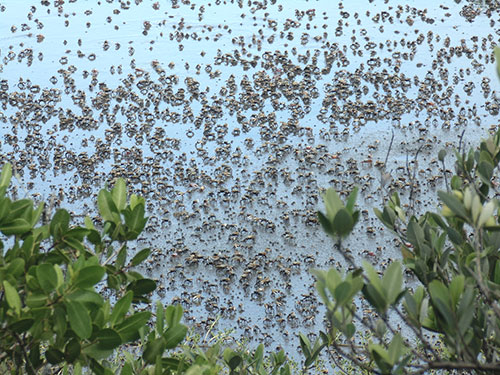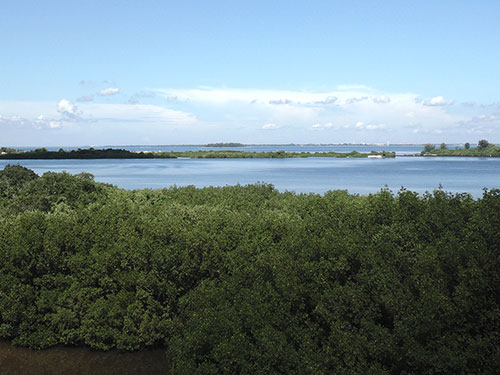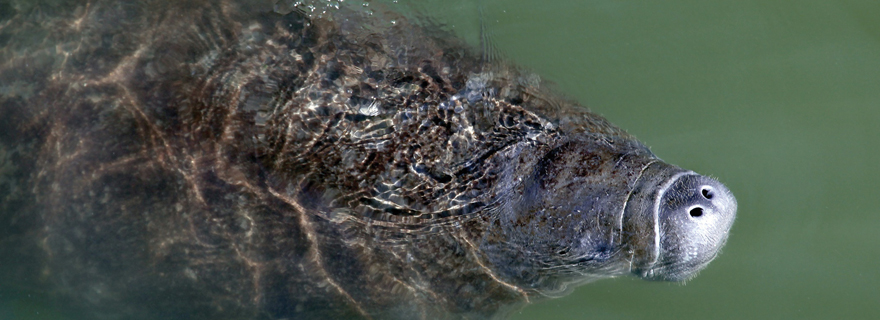And with free admission and parking, it’s ranked as the fourth most popular attraction in the region by TripAdvisor.
“When we first opened in 1986, the average visitor stayed about 30 to 45 minutes – now they stay for so long we had to open an overflow parking lot and set up shuttle buses to bring people back and forth,” notes Stan Kroh, manager of land and stewardship programs for Tampa Electric Company (TECO).

As you plan a trip, remember that you’ll see more manatees the colder it gets. “They really only show up when water temperatures in the bay start to drop below 68 degrees, so some of our visitors who come on warmer days are disappointed,” Kroh said.
A series of handicapped accessible decks lead to a 15-foot-high platform overlooking the canal and the stars of the show – manatees. An environmental education center building presents a series of colorful displays about manatees and their habitats, including actual manatee bones. Other displays focus on how TECO generates environmentally responsible power and how it prepares for major storms.
As you leave the viewing platform, stroll through the center’s award-winning butterfly gardens and Florida-friendly Landscaping (needs trademark symbol required by IFAS) for ideas to take home. And be sure to check out the newest attraction – a new Tampa Bay Rays touch tank with rays that are on displayed at Tropicana Field during baseball season.
A handicap-accessible oyster shell path winds through the site, connecting various facilities and offering a unique view of natural Florida. A highlight is a 50-foot-tall wildlife observation tower that offers sweeping views of surrounding wetlands as well as downtown Tampa and St. Petersburg. New boardwalks installed this summer will make the trail accessible even after heavy rains.
The tower and boardwalk also are accessible to canoers and kayakers who come from Tampa Bay through the Apollo Beach embayment or down Newman’s Branch Creek, along with a collection of picnic tables near the tower. (All facilities are closed except during the manatee center’s Nov. 1 to April 15 season.)
The trail also leads to the Florida Fish and Wildlife Conservation Commission’s student center where an exhibit area focused on protecting and restoring natural resources will be open to the public while the Manatee Viewing Center is open. The handicap-accessible second-floor open-air porch is another delightful spot to watch birds and fish in adjacent wetlands areas.
Learn more.

What to Know If You Go
The Manatee Viewing Center and its associated trails, exhibits and boardwalks are open from 10 a.m. to 5 p.m. most days between Nov. 1 to April 15. Admission and parking are both free.
To access the tower and nature park, you should know:
- Be prepared for an approximately half-mile walk; select the right shoes.
- There are no restrooms at the tower site, habitat trail and boardwalk.
- To get to the top of the tower, you must climb several flights of steps.
- Apply bug spray and dress appropriately (the tower will be closed in the event of severe weather).
- Visitors with sensitive health conditions, including those aggravated by exertion, should use caution if they decide to go to the tower.
- No food or water is available at the tower.
- Except for service dogs, pets are not allowed on the trail.
- Feeding wildlife is prohibited.
Manatees anchor unique conservation center
While manatees may always be the reason most visitors make the drive to Apollo Beach, the 500-acre waterfront parcel – originally purchased to buffer the power plant from nearby neighborhoods – is setting a new standard for public-private partnerships across the country.

The Manatee Viewing Center now anchors the Florida Conservation and Technology Center, a partnership of TECO, the Florida Fish and Wildlife Commission, The Florida Aquarium and the University of Florida.
Already completed is FWC’s first-ever coastal youth education facility which hosts students from across the region who spend the day learning about the importance of estuaries and how to fish, hike and kayak on specially built ponds that connect to Tampa Bay through the restored Newman’s Branch Creek.
“An amazing number of children who have lived in Tampa their entire lives don’t see estuaries or even beaches,” notes Kathy Guindon, the youth center’s director. “We’re open to students from grades three to 12 at no charge so we can teach the next generation to care about our water resources.”
Classes meet state education standards and are open to public and private schools, as well as home-school groups. Week-long summer camps are planned for students in grades three to eight.
Just south of the FWC’s Suncoast Youth Conservation Center, the University of Florida and The Florida Aquarium sponsor graduate-level classes and world-class research on corals, sea urchins and the turtles in Tampa Bay. (Yes, they do live in the bay for parts of their lives but little is known about them and they’re seldom seen even by avid fishermen. Count on a follow-up story in Bay Soundings soon.)
Two professors – Joshua Patterson, an aquaculture expert from Louisiana State University, and Mark Flint, an internationally recognized veterinarian specializing in sea turtles – work jointly for UF and the aquarium. They are currently housed in a modular building, but plans call for the construction of a facility where students from around the world can conduct research. Other students will learn remotely through webinars and other distance-learning programs.
Also on the drawing boards are eight greenhouses under construction by The Florida Aquarium for coral research and a “turtle hospital” to rehabilitate sick or injured sea turtles. While they won’t be open to the public for shows, they are designed so that visitors can watch the work from outside as part of the pathways through the property.
One of the areas Patterson will focus on is cryptopreservation of coral – or freezing it so that rare species can be protected while scientists learn more about how to grow them in protected environments before releasing them in the wild. “We’ve already lost about 95% of some species of coral, like the Caribbean staghorn coral in the Florida Keys,” he said. “We’re working with the Coral Restoration Foundation and the Smithsonian Conservation Biology Institute in Hawaii, which has been developing these technologies for years and wants to share them with scientists in other regions.”

FWC’s marine fish hatchery, which focuses on cost-effectively raising and releasing fish including snook and redfish, will be moved to the site when it closes its Port Manatee facility. FWC already operates a marsh grass facility where grasses grown on the TECO lands are transplanted to sites across the state.
TECO – now owned by Canadian-based Emera – recently purchased 100 acres nearby to build a state-of-the-art photovoltaic array on towers that automatically track the sun. “Emera is very big into renewable power and sustainability, but it’s hard to imagine finding enough land for solar if you need 100 acres for every 3,000 homes,” Kroh notes. “The goal is to add 100 new megawatts from solar every year but this piece of property will only provide 18 megawatts.”
A new research facility planned for the site will host University of South Florida students who will study and document the impact of new types of electrical systems. “There’s still a lot of research that needs to be done,” Kroh said. “Renewable is obviously a great solution but distributive power – where electricity is generated on site – is highly efficient because it doesn’t have to travel through a grid to get to your house.”
[su_divider]